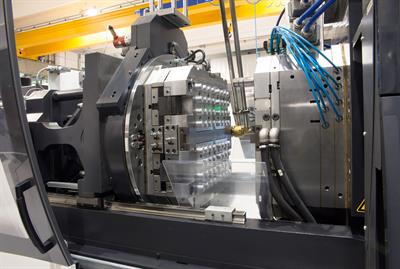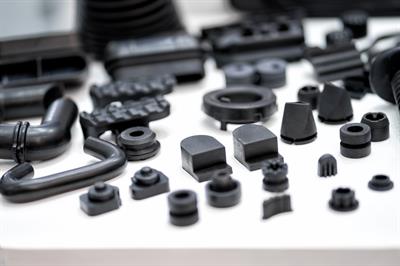What Is the Injection Molding Process for Molded Rubber Products?
 Injection molding is a cost-effective, speedy, and accurate way to manufacture high-volume rubber products. This molding method offers businesses ample advantages when producing large numbers of identical pieces with intricate shapes. Specifically, to mold rubber parts, injection molding saves manufacturing lines' time and is a relatively cost-saving process.
Injection molding is a cost-effective, speedy, and accurate way to manufacture high-volume rubber products. This molding method offers businesses ample advantages when producing large numbers of identical pieces with intricate shapes. Specifically, to mold rubber parts, injection molding saves manufacturing lines' time and is a relatively cost-saving process.
The injection molding process has been around since the late 19th century but only recently gained popularity due to technological advances that allowed manufacturers to create more intricate designs with greater precision than ever before. Today, injection molded rubber products are used in everything from automotive components to medical devices and toys, all thanks to the efficiency of this manufacturing process. Join us as we explore rubber injection molding: from what it is to how it works for creating perfect rubber products.
What Is Injection Molding?
Injection molding is a manufacturing technique used to produce parts and products by injecting molten material into a mold. It is one of the most widely used processes in producing plastic and rubber parts due to its low cost, speed, and accuracy. It also allows manufacturers to rapidly create intricate parts with complex geometries that would otherwise be too expensive or difficult to achieve with other methods.
Why Is Injection Molding Used for Rubber Parts?
Rubber material is often an ideal choice for injection molding because of its ability to be molded into complex shapes while still maintaining structural integrity. Additionally, rubber has superior wear resistance compared to other plastics making it an ideal choice for many applications such as automotive components, https://www.stonermolding.com/resources/knowledge-base/knowledge-base/2023/10/24/injection-plastic-molding-and-its-importance-in-the-medical-industry medical devices, sporting equipment, electrical components, toys, and more.
The average cycle time in rubber molding is low, thanks the preheating of the raw material which makes it easily flow into the mold cavity. Shorter cycle times makes rubber injection molding ideal for large applications, such as automotive interiors or consumer goods, where identical pieces are needed in massive quantities. It is a swift, efficient way to craft intricate rubber components that are durable and resilient. Its simplicity has made it popular among manufacturing companies around the globe—far outshining other processes in terms of convenience and productivity.
How The Injection Molding Process Works For Rubber Material
Although we've quickly discussed injection molding, some specific details regarding molded rubber products should be highlighted. Rubber molding methods are comparable to other goods produced by injection molds but with slight distinctions in preparation, formation, and heating processes. Here's a step-by-step guide on how custom-molded rubber parts take shape through injection molding:
1. Preparation of The Mold and the Rubber Material
Before the molding process starts, rubber injection molders ensure the mold surface is clean and build-up is removed. The mold surface is then layered with a mold release to ensure the finished rubber product comes out easily.
The next step in Injection rubber molding is preparing the raw rubber material. Molders weigh out the correct rubber material and add any necessary additives to achieve its desired characteristics such as softness and flexibility, to form a thick homogenous mixture known as a "compound." Then, the compound is put into the injection molding machines.
2. Injection of The Rubber Compound
The compound is then sent to the injection machine, consisting of an injector that holds the substance and a heated chamber known as a “die," made up of two hardened steel plates. These die plates are crafted precisely, so all rubber products produced will have exact sizes each time.
3. Creation of the Custom-Molded Rubber Products
Once the injection machine is activated, two plates close securely together to form a vacuum-like seal that prevents any rubber from escaping during the injection process. Using hydraulic pressure, the rubber compound is forced into every corner of the die cavity under great force at temperatures ranging from 400 to 570 degrees Fahrenheit (200 to 300 degrees Celsius.)
4. Heating The Rubber Injection Material
Heat's plasticizing action causes chemical and mechanical changes in individual rubber molecules. This part of injection molding cannot be seen with the naked eye but is a crucial part of the production process. This action causes them to bond together, forming continuous phases without voids or air pockets, which precisely replicates the desired design of your custom-molded parts.
5. Cooling The Rubber Molding Material
After filling out all cavities in the die with molten rubber, it gets cooled down using chilled water lines built within the die's cavity walls. Each machine's optimal cooling downtime per cycle is based on the machine type and the compound being used. This part of the method is not visible to the operator but is necessary to ensure that custom-molded rubber products are created based on the manufacturer's quality standards.
6. The Final Custom-Molded Rubber Product
After the rubber has been molded, it is then released from the die. This can be achieved through side-action cores or ejector pins depending on the complexity of custom-molded rubber parts being manufactured. If the right mold release was applied at the beginning of the process, the part should release without issue.

What Are the Benefits of Using Rubber Injection Molding?
Rubber molding is not only a highly efficient and cost-effective method for making custom molded rubber parts and products, but there are plenty of other benefits to it as well. Rubber molding offers numerous advantages over other manufacturing methods, including:
- Increased Design Flexibility: Injection rubber molding allows the creation of complex rubber designs with precision tolerances. It is also a great asset when adapting quickly and easily to production amounts for various projects or uses.
- Enhanced Durability: Injection molded rubber is extremely resistant to wear and tear, making it ideal for parts that require long-term durability. Rubber molding also produces an extremely dense finished product that is less likely to crack or break over time.
- Increased Sustainability: Injection methods for industrial rubber molded products reduce costs by decreasing the amount of scrap material created during production and minimizing labor requirements compared to traditional manufacturing processes. Additionally, this process has a very low cycle time, allowing for larger amounts of custom molded rubber products to be produced quickly and efficiently.
- Unmatched Quality Control: The consistency of each product produced via injection rubber molding is enhanced. This is due to the automated nature of the process, which allows for detailed quality inspections throughout the manufacturing cycle. By using this method, manufacturers can ensure that their molded rubber parts meet stringent industry standards each time they are produced.
Industrial Molding Products to Decrease Cycle Times & Increase Profits from Stoner Molding Solutions
Creating quality, injection-molded rubber products does not have to take away time or decrease your bottom line. Stoner Molding Solutions is here to help you create your products without error and in a short timeframe with our line of mold releases, mold sealers, and other industrial molding agents. Contact our team of molding professionals today for questions or request a sample of one of our products!
RESOURCES:
https://www.rpmrubberparts.com/blog/injection-rubber-molding/
https://www.iqsdirectory.com/rubber-injection-molding
https://qualiformrubbermolding.com/resources/rubber-molding-process/
